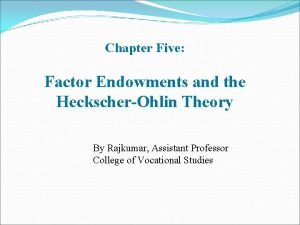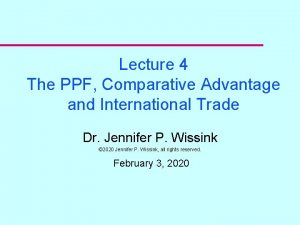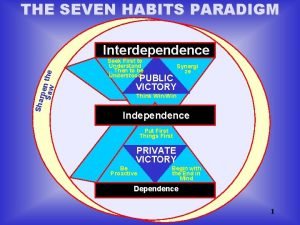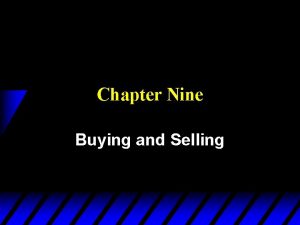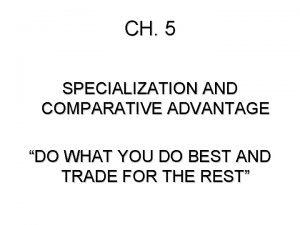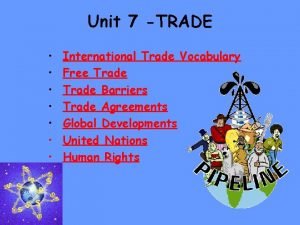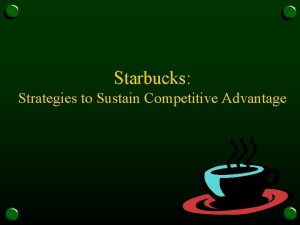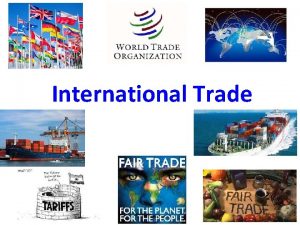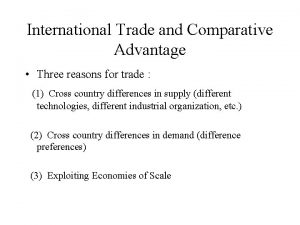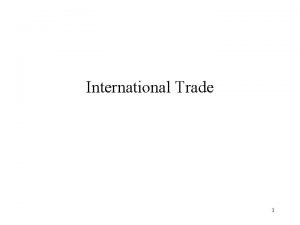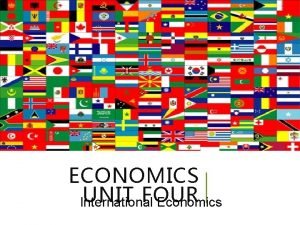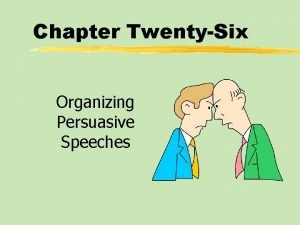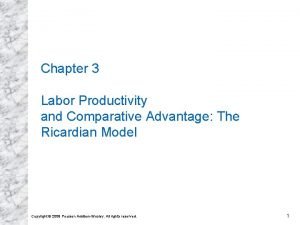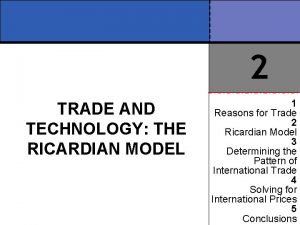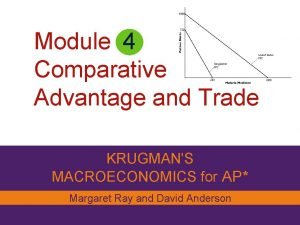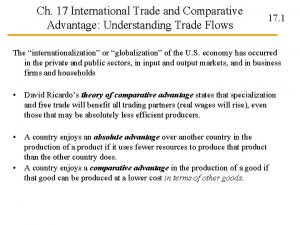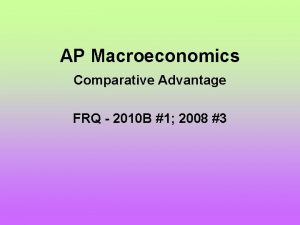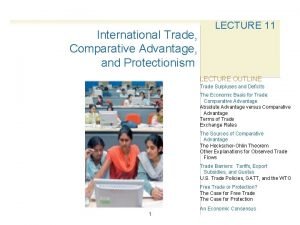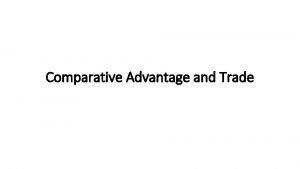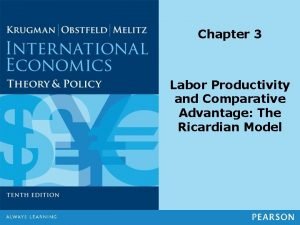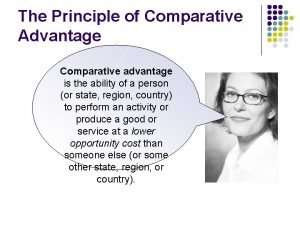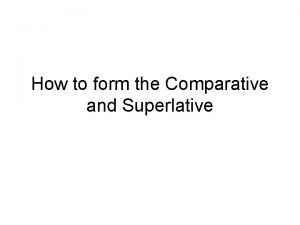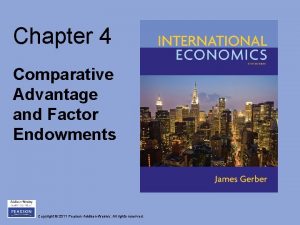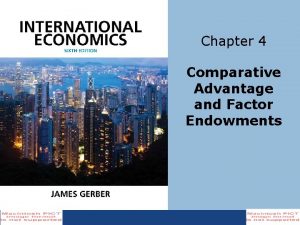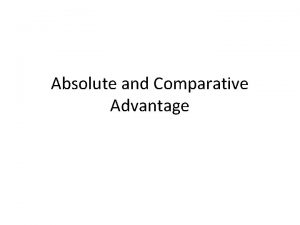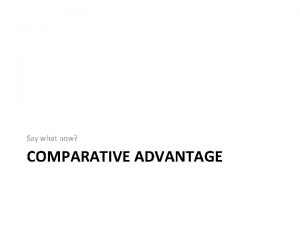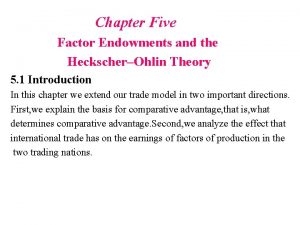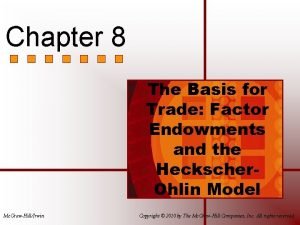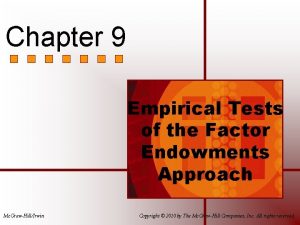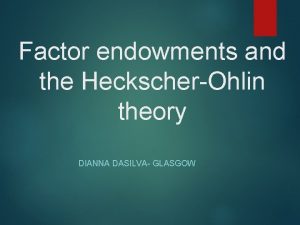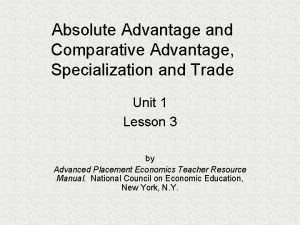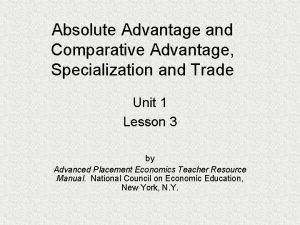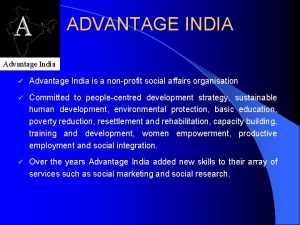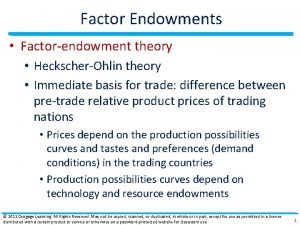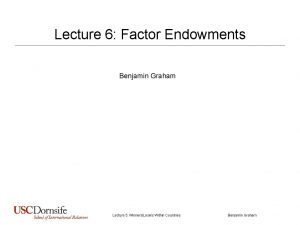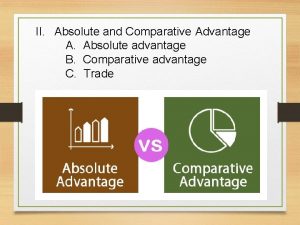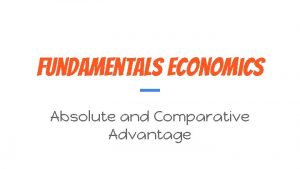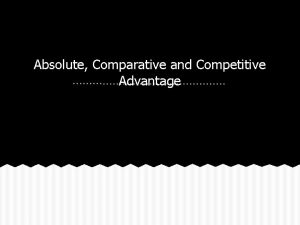Chapter 4 Comparative Advantage and Factor Endowments Chapter




























- Slides: 28

Chapter 4 Comparative Advantage and Factor Endowments

Chapter Objectives • Analyze the factors causing differences in the countries’ comparative advantage – Heckscher-Ohlin model • Present economic models on the impact of trade on income distribution – Stolper-Samuelson theorem – Specific factors model • Discuss the results of empirical tests on comparative advantage Copyright © 2005 Pearson Addison-Wesley. All rights reserved. 2

Introduction • Adam Smith and David Ricardo assumed that each country would have its own technology, climate, and resources, and that these differences would give rise to productivity differences (and thus differences in comparative advantage) • According to 20 th century economists, productivity differences between countries arise from differences in the factors of production Copyright © 2005 Pearson Addison-Wesley. All rights reserved. 3

Heckscher-Ohlin (HO) Theory • Argument: A country’s factors of production (country’s endowments of inputs) used to make each good give rise to productivity differences between countries – Factor abundance versus factor scarcity: when a country enjoys a relative abundance of a factor, the factor’s relative cost is less than in countries where the factor is relatively scarce – A country’s comparative advantage lies in the production of goods that use relatively abundant factors Copyright © 2005 Pearson Addison-Wesley. All rights reserved. 4

Heckscher-Ohlin (HO) Theory (cont. ) • Canadian capital-labor ratio: Kcan / L can is 2/10 or 1/5 • U. S. capital-labor ratio: Kus / L us is 50/150 or 1/3 • Since the U. S. ’s capital-labor ratio is higher, it is the capital abundant country: (KU. S. / L U. S. > KCan. / LCan. or 1/3 > 1/5 ) Copyright © 2005 Pearson Addison-Wesley. All rights reserved. 5

HO Model’s Prediction of U. S. Export Basket • The U. S. is richly endowed with a wide variety of factors: natural resources, skilled labor, and physical capital – Expectation: The U. S. will export agricultural products (particularly those requiring skilled labor and physical capital) and machinery and industrial goods (requiring physical capital and scientific and engineering skills) – Result: Major U. S. exports include grain products made with small labor and large capital inputs; and commercial aircraft made with physical capital and skilled labor Copyright © 2005 Pearson Addison-Wesley. All rights reserved. 6

Gains from Trade in the HO Model: Basic Assumptions • Ricardian model assumed that each country faced a constant set of tradeoffs (e. g. , 2 loaves of bread for 3 tons of steel in the U. S. ) because of only one homogeneous input: labor • The HO model assumes: (1) multiple inputs—labor capital, land, etc. —and (2) variations in the quality of inputs • Thus, the PPC cannot be assumed to have constant costs. Under the HO model, each country has a rising opportunity cost for each type of production Copyright © 2005 Pearson Addison-Wesley. All rights reserved. 7

FIGURE 4. 1 The United States’ Production Possibilities Curve with Increasing Costs • As with constant costs, the tradeoff between bread and steel is equal to the slope of the PPC; however, since the PPC is curved, tradeoff is different at each point of production Copyright © 2005 Pearson Addison-Wesley. All rights reserved. 8

FIGURE 4. 2 Opportunity Costs and the Slope of the PPC Copyright © 2005 Pearson Addison-Wesley. All rights reserved. 9

FIGURE 4. 3 Gains from Trade in the HO Model • If the U. S. exploits it comparative advantage and increases steel production, the gap between the opportunity cost of production and the trade price narrows • At B, they are equal: B maximizes U. S. income Copyright © 2005 Pearson Addison-Wesley. All rights reserved. 10

Trade and Income Distribution • The HO model provides a more sophisticated way to analyze the impact on different groups from trade – There are more inputs than labor – Labor can be divided into categories of different skill levels – Industries can require different mixes of various inputs • There is a systematic relationship between the factor endowments of a country and the winners and losers from trade • Let’s analyze this claim further… Copyright © 2005 Pearson Addison-Wesley. All rights reserved. 11

Stolper-Samuelson Theorem • Derived from the HO model • Assumptions – Labor earns wages proportionate to its skill level – Owners of capital earn profits – Landowners earn rents – The amount of income earned per unit of input depends on both the demand for inputs and the supply of inputs (demand for an input = derived demand) – If an output is in high demand, its price is high and the inputs used to produce it receive higher returns Copyright © 2005 Pearson Addison-Wesley. All rights reserved. 12

Stolper-Samuelson Theorem (cont. ) • Argument: An increase in the price of a good raises the income earned by factors that are used intensively in its production • Conversely, a fall in the price of a good lowers the income of the factors used intensively in its production Copyright © 2005 Pearson Addison-Wesley. All rights reserved. 13

FIGURE 4. 4 The Stolper-Samuelson Theorem Copyright © 2005 Pearson Addison-Wesley. All rights reserved. 14

Stolper-Samuelson Theorem (cont. ) • Note: Not all factors used in the export industries will be better off, and not all factors used in import competing industry get hurt: abundant factors will benefit, while scarce ones will be hurt – In addition, factors face magnification effect—the change in put prices has a magnified effect on incomes: 75% decline in the price of bread can lead to a more than 75% decline in the income of labor used in the production of bread Copyright © 2005 Pearson Addison-Wesley. All rights reserved. 15

Stolper-Samuelson Theorem (cont. ) • Ultimately, the effect of trade opening on income distribution depends on the flexibility of the affected factors – If labor is stuck in bread production and unable to move to making steel, it will be hurt much worse than when it is flexible and free to move – U. S. avocado producers might not oppose Mexican avocado imports as fiercely as they do, if they could easily move to producing other goods Copyright © 2005 Pearson Addison-Wesley. All rights reserved. 16

Specific Factors Model • HO model assumes that factors are mobile: migrate easily from one sector to another • Specific factors model assumes that: (1) land capital are immobile and cannot migrate; and (2) labor is fully mobile and can migrate from one sector to another Copyright © 2005 Pearson Addison-Wesley. All rights reserved. 17

Specific Factors Model (cont. ) • A country’s endowment of a specific factor plays a more critical role than a factor in the HO model in determining comparative advantage – When trade opens, incomes rise for the owners of the abundant specific factor – Income distribution effect on labor is indeterminate, as workers can easily move to the expanding sector Copyright © 2005 Pearson Addison-Wesley. All rights reserved. 18

Specific Factor Model (cont. ) Copyright © 2005 Pearson Addison-Wesley. All rights reserved. 19

Empirical Tests of Comparative Advantage Theories • Tests of theories based on factor endowments yield mixed results – Empirical tests are difficult: how to measure factor endowments or prices in an autarky, e. g. ? • Besides factor endowments, trade is affected by – technological differences – economies of scale – corporate structures – economic policies Copyright © 2005 Pearson Addison-Wesley. All rights reserved. 20

Extensions of the HO Model • There are several alternative trade models that elaborate on theory of comparative advantage – Product cycle model: focuses on the speed of technological change and life history of many manufactured items through periods of innovation, stabilization, and standardization – Intra-firm trade model: allows for comparative advantage but incorporates industrial organization Copyright © 2005 Pearson Addison-Wesley. All rights reserved. 21

Product Cycle • Developed by Raymond Vernon • Argument: Production of a good is cyclical – When a manufactured good is developed, producers experiment and seek consumers’ reactions – When production leaves the early stage, the good begins to be standardized in terms of size, features, and manufacturing process – Finally, consumption of the good in a high-income country exceeds its production: production moves where labor costs are lower Copyright © 2005 Pearson Addison-Wesley. All rights reserved. 22

FIGURE 4. 5 The Product Cycle in High-Income Countries Copyright © 2005 Pearson Addison-Wesley. All rights reserved. 23

FIGURE 4. 6 The Product Cycle in Low-Income Countries Copyright © 2005 Pearson Addison-Wesley. All rights reserved. 24

Foreign Trade vs. Foreign Investment • Much of international trade is driven by foreign investment by multi-national firms – Firms prefer to invest abroad and produce there directly, rather than export (they substitute foreign investment foreign trade) – Output produced in the foreign operation can be sold directly to the foreign market or shipped back to the home nation (they engage in intra-firm trade to take advantage of advantageous foreign conditions) Copyright © 2005 Pearson Addison-Wesley. All rights reserved. 25

Foreign Trade vs. Foreign Investment (cont. ) • Reasons for intra-firm trade – Firms take advantage of cross-country differences in the price of inputs – A firm may reduce distribution costs in a foreign market by operating through an affiliate • Intra-firm trade is growing in importance – In mid-90’s, about 1/3 of US merchandise exports and 2/5 of merchandise imports were intra-firm Copyright © 2005 Pearson Addison-Wesley. All rights reserved. 26

Foreign Trade vs. Foreign Investment (cont. ) • OLI theory (Ownership-Location. Internalization) – Firms investing abroad own an asset that gives them an competitive advantage (Ownership) – Firms seek a production location that offers them advantages (Location) – Firms try to internally capture the advantages of foreign asset ownership (Internalization) Copyright © 2005 Pearson Addison-Wesley. All rights reserved. 27

Impact of Trade on Wages and Jobs • In the short-run, trade may (1) reduce jobs in an industry that is not competitive vis-à-vis foreign industries and (2) increase jobs in competitive industries • In the medium- and long-run, trade has very little effect on the number of jobs – The abundance or scarcity of jobs is a function of (1) labor market policies, (2) incentives to work, and (3) government macroeconomic policies Copyright © 2005 Pearson Addison-Wesley. All rights reserved. 28
 Factor endowment theory
Factor endowment theory Comparative advantage ppf
Comparative advantage ppf The seven habits paradigm
The seven habits paradigm Selling endowments
Selling endowments Actual mechanical advantage vs ideal mechanical advantage
Actual mechanical advantage vs ideal mechanical advantage Specialization and comparative advantage
Specialization and comparative advantage When discussing comparative and absolute advantage
When discussing comparative and absolute advantage Peak factor formula
Peak factor formula Least common multiple of 12 and 42
Least common multiple of 12 and 42 Trade vocabulary
Trade vocabulary Starbucks competitive strategy
Starbucks competitive strategy Comparative advantage calculation example
Comparative advantage calculation example How to calculate comparative advantage
How to calculate comparative advantage Ricardo's theory of comparative advantage
Ricardo's theory of comparative advantage Comparative advantage example
Comparative advantage example Comparative advantage calculation example
Comparative advantage calculation example Refutation organizational pattern
Refutation organizational pattern Comparative advantage numerical example
Comparative advantage numerical example Trimalawn
Trimalawn How to calculate comparative advantage
How to calculate comparative advantage Comparative advantage
Comparative advantage Comparative advantage exists when one person can produce
Comparative advantage exists when one person can produce Calculating comparative advantage
Calculating comparative advantage Ap macroeconomics frq 2010
Ap macroeconomics frq 2010 Comparative advantage
Comparative advantage Advantedge power island
Advantedge power island Comparative advantage example
Comparative advantage example Comparative advantage example
Comparative advantage example Comparative adjectives tall
Comparative adjectives tall
